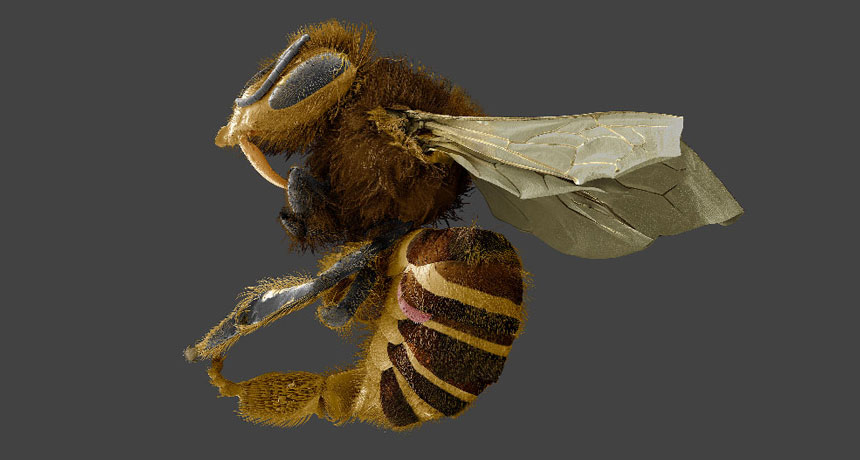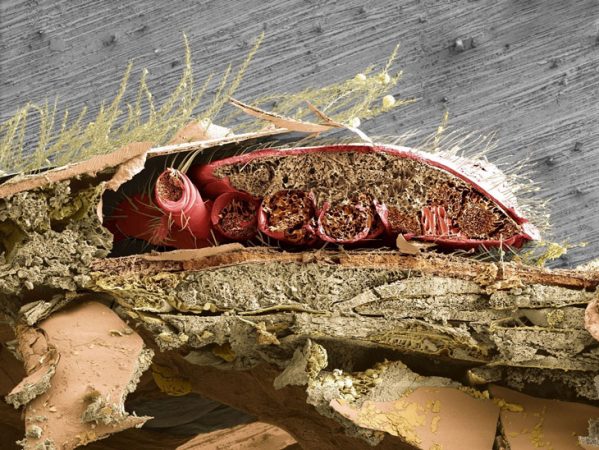Bee parasite is more werewolf than vampire
That may finally explain why Varroa destructor mites are a nightmare for a beehive

Varroa destructor mites (one shown in pink on a honeybee) have long been a plague for honeybees. But they may have been misunderstood for decades. It may not so much bee “blood” but fat they’re after.
UMD, USDA, PNAS
By Susan Milius
Scientists have given a tiny mite the ominous name Varroa destructor. This parasite lives on honeybees. Scientists had thought it was a “vampire,” living off of bee blood. But tests with fake bee larvae reveal that the mite may not be so much a bloodsucker as a fat slurper. That makes the mite more werewolf than vampire, the researchers say.
The parasite invaded North America in the 1980s. Since then, it has become one of the biggest threats to honeybees. Based on research from the 1970s, scientists thought that the mites fed on the bee version of blood. It’s called hemolymph (HE-moh-limf). But the mites are actually after the fat, proposes Samuel Ramsey. He is an entomologist or insect specialist. He researched this idea while at the University of Maryland in College Park.
That insight might help people create mite-killing medicines to feed to bees, says Aaron Gross. He’s a toxicologist at Virginia Tech in Blacksburg. While there are mite-killing pesticides, beekeepers could really use some new choices, he says. One big reason: Some groups of mites don’t die when treated.
Ramsey’s rethink started with Varroa biology. Some things didn’t seem to fit with the blood hypothesis. Many bloodsucking species have a flexible body that can swell when the animal drinks a lot. Some have guts with fancy filters that pull nutrients from water. Varroa mites, though, don’t have these traits. And hemolymph is so weak and watery that Ramsey found it odd mites live on it.
So he spent about a year inventing artificial bee larvae. He made the fakes out of gelatin-based pill capsules. These let him test how well mites survived when fed different things. He filled the fake larvae with different foods. Some held only hemolymph. Mites feeding on them lived an average of just 1.8 days. Other fakes had mixed food inside. Only a few mites survived the whole seven-day test. However, all survivors dined on half or solely fat.
Those tests plus other signs suggest mites need bee fat, Ramsey and his colleagues argue. They described their tests January 29 in the Proceedings of the National Academy of Sciences. Rather than sucking blood, the mite “is feeding on flesh more like a werewolf,” Ramsey concludes.
Focusing on fat
In another part of the study, the researchers fed adult bees two stains. Nile red stained their fat. Yellow uranine stained their “blood.” Skilled microscope specialists then took images of the mites’ guts after feeding on fat. Guts glowed red. When the parasites fed on bees with stained hemolymph, the mite guts looked ghostly dim.
Says Ramsay: Those tests show that mites target adult bee fats.

“The experiments seem to be reliable, and the results are convincing,” says Peter Rosenkranz. He studies bee health and directs Germany’s Agricultural State Institute. It’s based at the University of Hohenheim in Stuttgart.
Thinking about fat could explain more about how mites harm bees, says Ramsey. An organ in bees known as the fat body breaks down pesticides. It also helps the year’s late larvae grow so that they can live extra long and survive the winter. The mites might make pesticides and winters worse, he says.
Damaging bee fat also may reduce bees’ immune response, says Lena Wilfert. She’s an evolutionary ecologist at the University of Ulm in Germany. Mites spread viruses among bees. Those viruses might do more to bees without normal fat bodies.
When a larva is ready to metamorphose into an adult, nurse bees seal the larva in a cell. A female mite can slip into the cell right before sealing. There, she lays eggs. When that bee later emerges as an adult, the mother mite and her daughters hitch along. They often then switch to nurse bees. Those nurses have especially large fat bodies. The mites clamp onto an area near the bee fat body. But the mites aren’t just riding, Ramsey says. Wound openings on bees are shaped like mite mouthparts. Also, internal damage shows up in images taken through a microscope.
Creating those decoy larvae from gelatin capsules to study mite behavior in the lab wasn’t easy. The smallest pills still have walls too thick for mites’ teeny mouthparts to pierce. Ramsey had to work out a way to carefully replace the bottom of a pill with a film stretched to a thickness of only 15 micrometers — about the width of a very thin human hair. Rubbing the film over real bees to transfer scent eventually coaxed mites to taste the fakes. Rearing mites without bees has been a very hard problem. However, Ramsey says, “I’m very, very, very bad at giving up.”







